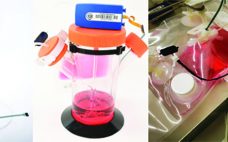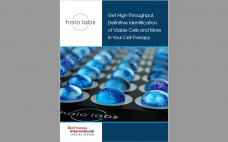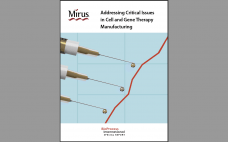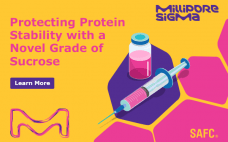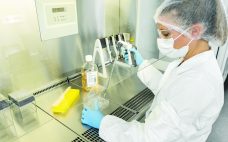A process analytical technology (PAT) strategy involves defining critical process parameters (CPPs) of a biomanufacturing process that influence critical quality attributes (CQAs) and controlling those CPPs within defined limits. Doing that enables consistent product quality and helps companies reduce waste and costs. Glucose is an important CPP in bioprocessing and cell therapy. Glucose often is fed as a bolus addition based on daily off-line measurements, but that can lead to high glucose fluctuations and to excessive glucose feeding, which can…
Sponsored Content
Realization of Quality By Design and Beyond: The Intelligent Cell Processing System
Cells are used as raw materials, intermediates, and final products in biopharmaceutical and cell therapy manufacturing. Because living cells are always in a dynamic state, their characteristics must be kept within specified ranges throughout bioprocessing to preserve their utility. Cell population expansion without changing the original cell properties is key for obtaining the required number of cells at the next step. However, limited process data are collected during the expansion phase — information that could be used to understand and…
Rethinking Chromatography
Dynamic trends in the biotherapeutic industry are shifting manufacturers towards new modalities and intensified production strategies. This development is supported by ongoing scientific and technical advances in both upstream and downstream processing steps. Downstream processing of new modalities requires chromatography technologies that can handle large, fragile molecules (such as mRNA and viral particles). To maximize speed and productivity, platforms supporting continuous processing will become essential. In this feature, Sartorius discusses current and future concerns for process chromatography operations. They then…
Development of an Automated AAV8 Capsid Titer Assay on Gyrolab® xPand Immunoassay Platform
This webcast features: Matthew Lotti, Senior Research Associate, Ultragenyx. The fast-growing gene therapy industry is in pressing need for fast and reliable analytical methods to accelerate bioprocess development and manufacturing of AAV viral vectors. Matt Lotti, Senior Research Associate II at Ultragenyx, a pharmaceutical company developing therapies for patients with rare genetic diseases, will present how the Analytical Development team at Ultragenyx developed a Gyrolab-based assay that demonstrates acceptable accuracy and precision for supporting in-process testing of AAV8 capsid titer.…
Get High-Throughput, Definitive Identification of Viable Cells and More in Your Cell Therapy
Analyzing for viable cells using traditional methods such as flow cytometry often encounters clogging resulting in the loss of precious cell therapy samples. Not only is it low throughput, but incredibly complicated, which can lead researchers to misidentify cellular and non-cellular material and confuse cell viability results with product-purity issues. Additionally, it is a regulatory requirement for all injectable drug products be characterized for sub visible particles (SVP) and aggregates that may form during a manufacturing process. With Backgrounded Membrane…
Addressing Critical Issues in Cell and Gene Therapy Manufacturing
Recombinant lentivirus (LV) and adeno-associated virus (AAV) are critical components of cell and gene therapies, which show great promise for treatment of diseases from genetic disorders to cancer. Accordingly, there is an unprecedented need for high titer and large-scale viral vector manufacturing processes to support the growing number of researchers developing biotherapeutics for immunotherapy. Download this Special Report, highlighting: Evolutions of gene therapy manufacturing Improvements to GMP raw-material sourcing. Role of transfection reagents like VirusGEN® GMP as a turnkey element…
Protecting Protein Stability with a Novel Grade of Sucrose
Ensuring the chemical and physical stability of the therapeutic protein is critical to the safety and efficacy of biopharmaceuticals and presents one of the major challenges in formulation. A number of excipients, including sugars, can be used to solve this problem. Sugars are stabilizers that maintain conformational stability by preferential exclusion and function as cryo- and lyoprotectors in lyophilized formulations. Given these properties, it is not surprising that sucrose is one of the most widely used stabilizers in marketed drug…
Modernize Your Gene Therapy Analytics with Automated Tools from Bio-Techne
This webcast features: Chris Heger, PhD, Director of Applications Science, Bio-Techne. Modern medicines call for modern technologies. Gene therapy is an exciting approach at work to cure diseases, where genetic material is delivered to a patient via a viral vector. This approach requires a doubly complex drug that contains both protein and oligonucleotides, and existing analytical tools just don’t meet the quantitative needs of these complicated therapeutic agents. In this webinar, hear how a variety of innovative analytical tools from…
Finding the Right Partner for Outsourced Cell-Line Development
The successful commercialization of a biopharmaceutical product begins with a robust and productive cell line. Inefficient cell-line development (CLD) can lead to costly delays and roadblocks. For that reason, small, new, and virtual companies — and even established and mid-size companies — often seek the support of outsourcing partners to develop their cell lines. Outsourcing CLD activities can ease many pressures associated with manufacturing new biotherapeutics. The benefits of outsourcing CLD and associated processes include access to specialized expertise and…
Reducing Cell and Gene Therapy Development Time and Cost with New Purification Strategies
The past 40 years have ushered in the most advanced medicines the world has ever seen, with tremendous improvements in biomanufacturing technologies to enable their development. Advances in production technology have brought significant improvements in upstream productivity, which then caused bottlenecks in downstream processing. Although many bottlenecks have been resolved for most biologics, new modalities such as gene therapies and mRNA vaccines are driving the need for differentiated purification solutions. Meanwhile, pressures to increase efficiency and reduce costs continue to…

